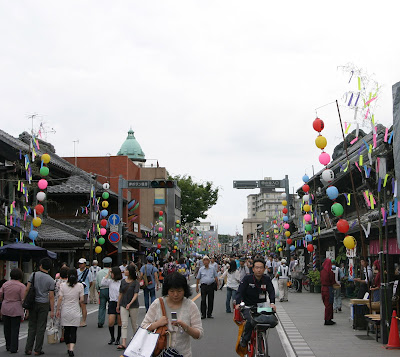Nick got home from his IA during the height of Bon season. We took advantage of a free weekend to take another base MWR tour to a festival in Kawagoe.

"Come with us to Kawagoe City and admire the radiance of the lanterns and revel in the celebration of the 'Million Lantern Festival'"

A few of our friends went with us and we decided to make it more fun by dressing up like the Japanese in traditional summer yukata's.


Though intimidating at first, yukatas aren't that hard to put on yourself (with the help of you-tube and a friend, of course!) The tour bus ride was almost two hours long- too long to sit all tied up in our yukatas- but as we got closer to our final destination we all attempted to change in the back of the bus.

The girls and I making our obi's (belts) look straighter...getting ready on a moving bus is hard!
The boys got a little impatient with us...of course their Japanese get-ups were a little less complicated!!!
First we visited the Kitain Temple...
"Kitain is a head temple of Tendaishu Buddhist sect in Kanto District. It was built in 830. Tenkai Dojo, who came to Kitain as an archbishop during the late 16th century, made it famous and thriving."

 "Tenkai earned the trust of Tokugawa leyasu who visited Kawagoe for hunting in 1611. The fire in 1638 destroyed the temple. Only the main gate escaped the fire. Lemitsu, the third Tokugawa Shogun ordered reconstruction of the temple. He answered the wish of Tenkai who wanted to move part of the buildings of Edo Castle to Kitain. This eventuated in the only one remaining structure of the original Edo Castle."
"Tenkai earned the trust of Tokugawa leyasu who visited Kawagoe for hunting in 1611. The fire in 1638 destroyed the temple. Only the main gate escaped the fire. Lemitsu, the third Tokugawa Shogun ordered reconstruction of the temple. He answered the wish of Tenkai who wanted to move part of the buildings of Edo Castle to Kitain. This eventuated in the only one remaining structure of the original Edo Castle."

 We got lots of..."Can we take a picture with you?"
We got lots of..."Can we take a picture with you?"
 Or..."Can we take-e your-a pic-a-ture?"
Or..."Can we take-e your-a pic-a-ture?"

On site is the historically popular Gohyaku-rakan (500 statues of Rakan).

"There are actually 540 stone statues that are arrange in a part of Kitain. Rakan translated literally means 500 disciples of Buddha. The statues on an average are not so tall, but have a variety of postures (standing, sitting and lying) and display several emotions (happiness, sadness, and anger)."

 After touring the temple, we made our way over to the famous streets of Kawagoe where the Hyakumanto Festival was to take place.
After touring the temple, we made our way over to the famous streets of Kawagoe where the Hyakumanto Festival was to take place.


Thee streets of Kawagoe are famous for their preservation of the old castle town of the Edo period...the Edo period is the time during Japanese history when the shoguns ruled from 1603 to 1868. The picture below is of the Toki-no-Kane (bell tower), one of the prominent sites. The bell tower serves as the symbol for Koedo and rings four times a day. Originally built over 400 years ago, it has burnt down and been rebuilt several times.
 "Since the Edo castle and it's surrounding area lost almost all historical properties in the devastating earthquake in 1923 and the bombings in WWII, the cultural properties of Kawagoe which had a close relation with Edo, have become extremely valuable to recall the culture of old."
"Since the Edo castle and it's surrounding area lost almost all historical properties in the devastating earthquake in 1923 and the bombings in WWII, the cultural properties of Kawagoe which had a close relation with Edo, have become extremely valuable to recall the culture of old."
Kashiya-yokocho, or "Candy Street," is where the festival took place. A busy street lined with sweet shops and vendors selling all kinds of sweet potato flavored goodies (among other things). Kawagoe is famous for its sweet potatoes...sweet potato ice cream, sweet potato coffee, and even sweet potato beer! (We tried the ice cream....it was ok, but wouldn't be my first choice of flavor)

Parades, lanterns, a large procession with portable shrines, lanterns, music, lanterns....


And at the end, a big drum competition....to see which group of drummers could out-play the others?!


Keeping the "old" alive is very important to the Japanese....they hold their ancient history very dear. Coming from America, a country so much younger than Japan, I am fascinated by Japan's rich cultural history. I love America, but am continually intrigued by Japan.

















No comments:
Post a Comment